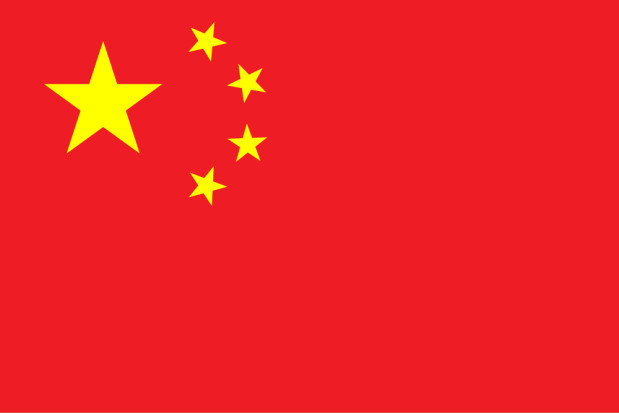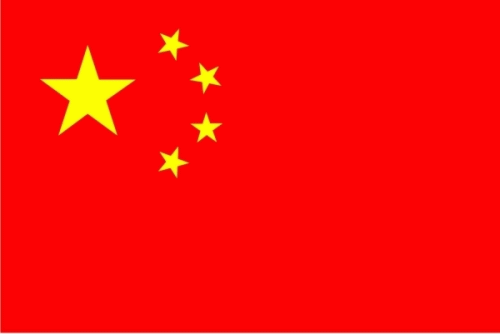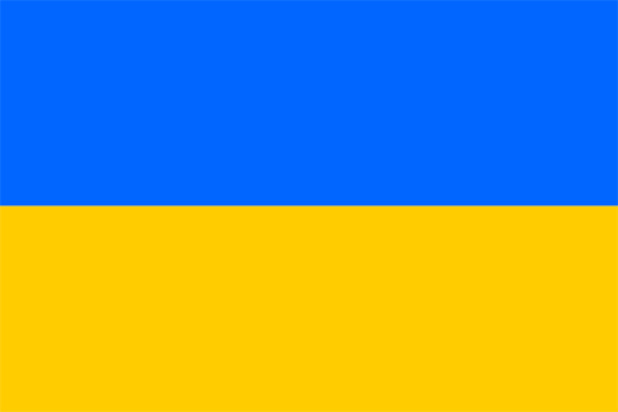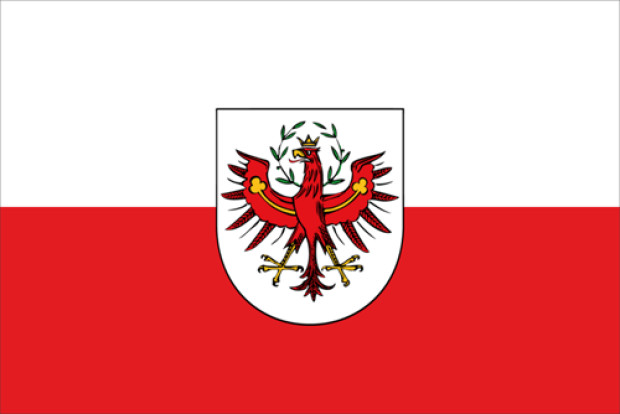Flag of China

Listen to anthem
Top sellers from our flag shop

Chile Flagge 60x90 cm
8,90 €
Show in shop
Argentinien Baseballcap Schrift Argentina Sonderangebot
9,90 €
Show in shopBackground knowledge
The flag of the Chinese Empire was solid yellow and featured a blue dragon in the center. The color yellow is the color of the Manchurian people and also of the Manchurian Qing Dynasty, which ruled China from 1644 to 1912. The dragon represents the East. A European style flag was introduced only in 1880. Before that, Chinese flags were shaped like pennants.
In 1912 the monarchy was overthrown and the republic was proclaimed. In this context, a new flag was introduced. It showed five horizontal stripes in red, yellow, blue, white and black. The five colors were meant to represent the five races of China: Red = Han Chinese, Yellow = Manchurian, Blue = Mongolian, White = Tibetan, Black = Turkestan (Uighur). Significantly, the red of the Han, the new state-bearing people, was at the top.
As early as 1895, a reform movement had organized, the Chinese Regeneration Society. The flag of this organization was solid blue, with a white twelve-rayed sun in the center. In 1912, the Guomindang National Republican Party was founded. The Guomindang chose a solid red flag with the blue flag of the Regeneration Society in the upper corner. In a long civil war, the Guomindang finally prevailed in 1928. The Guomindang flag became the new national flag.
In 1935, the Communists succeeded in establishing themselves in Shanxi Province. Their "People's Liberation Army" used a solid red flag with a gold star in the upper corner and with the numbers "1" and "8". They commemorate the founding date of the force, August 1, 1928. This flag is still the naval and war flag of Red China today. In 1931, the Japanese had occupied Manchuria, installing the satellite state of Manchukuo. In 1937, the Second Sino-Japanese War broke out, and Japan occupied large parts of China. A pro-Japanese government for China was in place in Nanking (Nanjing) until 1945, the year the Japanese left. This continued to use the Guomindang flag, but with the addition of a yellow pennant that included the words, "Peace and Anti-Communism." In the following civil war, which lasted until 1949, the communists prevailed against the Guomindang. The latter were able to escape to Taiwan. The island still uses the flags of the Guomindang.
On 01.10.1949 the People's Republic of China was founded by the victorious communists, and a new flag was introduced. It is solid red with one large and four small gold five-pointed stars in the upper corner. The red represents communism, but also still represents the Han. The five stars symbolize China, Manchuria, Mongolia, Sinkiang (East Turkestan), and Tibet, but also the Communist Party and the four working classes: Workers, peasants, petty bourgeois and "patriotic capitalists".
Red with one large and four smaller five-pointed stars.
Meaning
Red symbolizes both the communist revolution and the color of the historical Han Dynasty (206 BC). The large star symbolizes the Chinese Communist Party, while the four smaller stars are meant to remind us of the four social classes in China (workers, peasants, petty bourgeois and so-called "patriotic capitalists"). The flag has existed since 1949.
Hymn
Chinese flag color codes
- HEX
- #EE1C25
- RGB
- 238, 28, 37
- CMYK
- 0, 88, 84, 7
- RAL
- 3026
- Pantone
- 186
- HEX
- #FFFF00
- RGB
- 255, 255, 0
- CMYK
- 0, 0, 100, 0
- RAL
- 1026
- Pantone
- 102
That's what ChatGPT knows about the flag of China
-
The flag of the People's Republic of China is a symbol of the unity of the country and its unity as a nation. The flag consists of a red background with a golden star and four smaller golden stars in a semicircle. The golden star represents the Communist Party of China, while the four smaller stars symbolize the Four Classes of Chinese society. The country's flag has been used as the official symbol of the People's Republic of China since 1949.
-
The first national flag of China was introduced in 1912, when the Republic of China was founded. It consisted of a red background with a white crescent and a five-star symbol. This symbol later became the representation of the Five Star Movement, which represents the Communist Party of China. In 1949, the current national flag of China was introduced, which consists of a red background with four yellow stars. The largest star symbolizes the Communist Party, while the other three stars represent the working class, the peasantry and the army.
-
The national flag of China is a red square bearing a large gold five-star emblem in the upper left corner. The five stars symbolize the nation, the People's Republic of China, the Communist Party of China, the working class, the peasant people and the alliance of all ethnic groups. The national flag of China is a symbol of the country's unity and progress. It is a symbol of patriotism and solidarity of the Chinese people.
Flags of China
Cities
Discover something new
Random flags from our large flag database.









